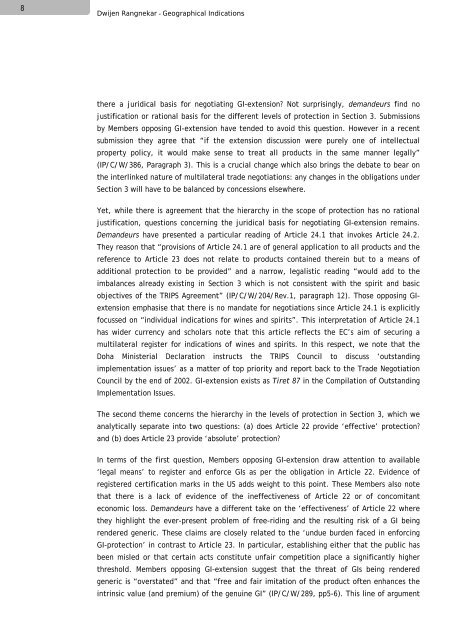Geographical Indications
Geographical Indications
Geographical Indications
You also want an ePaper? Increase the reach of your titles
YUMPU automatically turns print PDFs into web optimized ePapers that Google loves.
8Dwijen Rangnekar - <strong>Geographical</strong> <strong>Indications</strong>there a juridical basis for negotiating GI-extension? Not surprisingly, demandeurs find nojustification or rational basis for the different levels of protection in Section 3. Submissionsby Members opposing GI-extension have tended to avoid this question. However in a recentsubmission they agree that “if the extension discussion were purely one of intellectualproperty policy, it would make sense to treat all products in the same manner legally”(IP/C/W/386, Paragraph 3). This is a crucial change which also brings the debate to bear onthe interlinked nature of multilateral trade negotiations: any changes in the obligations underSection 3 will have to be balanced by concessions elsewhere.Yet, while there is agreement that the hierarchy in the scope of protection has no rationaljustification, questions concerning the juridical basis for negotiating GI-extension remains.Demandeurs have presented a particular reading of Article 24.1 that invokes Article 24.2.They reason that “provisions of Article 24.1 are of general application to all products and thereference to Article 23 does not relate to products contained therein but to a means ofadditional protection to be provided” and a narrow, legalistic reading “would add to theimbalances already existing in Section 3 which is not consistent with the spirit and basicobjectives of the TRIPS Agreement” (IP/C/W/204/Rev.1, paragraph 12). Those opposing GIextensionemphasise that there is no mandate for negotiations since Article 24.1 is explicitlyfocussed on “individual indications for wines and spirits”. This interpretation of Article 24.1has wider currency and scholars note that this article reflects the EC’s aim of securing amultilateral register for indications of wines and spirits. In this respect, we note that theDoha Ministerial Declaration instructs the TRIPS Council to discuss ‘outstandingimplementation issues’ as a matter of top priority and report back to the Trade NegotiationCouncil by the end of 2002. GI-extension exists as Tiret 87 in the Compilation of OutstandingImplementation Issues.The second theme concerns the hierarchy in the levels of protection in Section 3, which weanalytically separate into two questions: (a) does Article 22 provide ‘effective’ protection?and (b) does Article 23 provide ‘absolute’ protection?In terms of the first question, Members opposing GI-extension draw attention to available‘legal means’ to register and enforce GIs as per the obligation in Article 22. Evidence ofregistered certification marks in the US adds weight to this point. These Members also notethat there is a lack of evidence of the ineffectiveness of Article 22 or of concomitanteconomic loss. Demandeurs have a different take on the ‘effectiveness’ of Article 22 wherethey highlight the ever-present problem of free-riding and the resulting risk of a GI beingrendered generic. These claims are closely related to the ‘undue burden faced in enforcingGI-protection’ in contrast to Article 23. In particular, establishing either that the public hasbeen misled or that certain acts constitute unfair competition place a significantly higherthreshold. Members opposing GI-extension suggest that the threat of GIs being renderedgeneric is “overstated” and that “free and fair imitation of the product often enhances theintrinsic value (and premium) of the genuine GI” (IP/C/W/289, pp5-6). This line of argument









